
In this activity, students will practice introducing themselves. They will also have a brief review on a variety of topics.
- Subject:
- Languages
- Material Type:
- Activity/Lab
- Author:
- Camille Daw
- Amber Hoye
- Mimi Fahnstrom
- Date Added:
- 01/21/2021

In this activity, students will practice introducing themselves. They will also have a brief review on a variety of topics.

This lab introduces students to expectations for the rest of the semester. It also allows them to introduce themselves and get to know the rest of their group members.
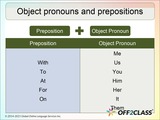
This lesson is perfect to use with beginner students. It is designed for introducing object pronouns to beginner students. Additionally, it is great to use as a practice or review lesson. In any case, when using this lesson students should have an understanding of how to use subject pronouns.If you want additional lesson plans and support, including teachers’ notes, be sure to register for a free Off2Class account.
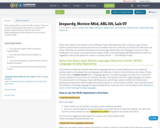
This activity will be a review for ASL students. There are categories like physical descriptions, numbers and shapes, and Deaf culture. There is also a short fingerspelling quiz for the students to practice their receptive skills.

Students will review holiday signs. Students will have a discussion on Deaf culture and how their thoughts on ASL/Deaf Culture have changed through the learning and experiences.

This lab will help students understand more about lipreading through a fun activity. Students will also get to work on their receptive skills with various sentences.

This resource is a video abstract of a research paper created by Research Square on behalf of its authors. It provides a synopsis that's easy to understand, and can be used to introduce the topics it covers to students, researchers, and the general public. The video's transcript is also provided in full, with a portion provided below for preview:
"Long non-coding RNAs (lncRNAs) regulate the transcription, translation, and post-translational modification of target genes and have been a recent target of interest in cancer research for their roles in regulating amino acid metabolism. Cancer cells undergo significant metabolic reprogramming and depend on amino acids as key nutrients. This reprogramming is a critical part of tumorigenesis and cancer progression. Thus, finding ways to measure or target metabolic reprogramming may lead to new diagnostics and treatment methods. Research has demonstrated that lncRNAs participate in the reprogramming of amino acid metabolism in cancer cells. However, there are still significant gaps in the literature. Namely, the secondary structures, functions, and molecular mechanisms of lncRNA action are not fully understood, and systemic studies on the function of lncRNAs in tumor amino acid metabolism are still needed. Further, current studies have a long way to go before reaching the clinical stage..."
The rest of the transcript, along with a link to the research itself, is available on the resource itself.

Contains tool overview and student examples

Contains Overview of Memory Boxes and 4 student examples

This resource is a video abstract of a research paper created by Research Square on behalf of its authors. It provides a synopsis that's easy to understand, and can be used to introduce the topics it covers to students, researchers, and the general public. The video's transcript is also provided in full, with a portion provided below for preview:
"Lung cancer is the leading cause of cancer-related deaths globally. Tyrosine Kinase Inhibitors (TKIs) are a common treatment for lung cancer, but TKI resistance is widespread. TKI treatment also has serious side effects like hair loss, anemia, and hypothyroidism, meaning it is important to identify which patients will benefit from the treatment. MicroRNAs may be a way to do that. MicroRNAs regulate gene expression by blocking transcription or promoting the breakdown of messenger RNA, and because microRNAs are stable in body fluids, they can be particularly useful as diagnostic or prognostic indicators in many applications. In the context of anti-cancer drugs, microRNAs are frequently directly involved in the cellular response. Profiling their expression could be used to predict the response to anti-cancer drugs like TKIs. The research to date has described numerous microRNAs and their roles in TKI response by lung cancer cells. However, most previous research did not measure microRNAs in serum samples..."
The rest of the transcript, along with a link to the research itself, is available on the resource itself.

This resource is a video abstract of a research paper created by Research Square on behalf of its authors. It provides a synopsis that's easy to understand, and can be used to introduce the topics it covers to students, researchers, and the general public. The video's transcript is also provided in full, with a portion provided below for preview:
"When it comes to immune functioning, cancers and autoimmune diseases are opposites. The key immune-related defect in cancer is subverting and evading the immune system, while autoimmune disease is, broadly speaking, an overactive immune system targeting the self. The immune system and the gut microbial community have a reciprocal influence on each other. Therefore, it is possible that cancers and autoimmune diseases have analogous but inverted impacts on the gut microbiome. To test this, researchers conducted a systematic literature review. The included studies covered over 10,000 people from 27 countries. This data revealed a set of microbiome features that show consistent, opposite changes in cancers compared to autoimmune diseases. Fusobacterium and Peptostreptococcus were the most consistently increased bacterial genera in cancer cases. While Bacteroides stood out as a group increased in autoimmune disease and decreased in cancers..."
The rest of the transcript, along with a link to the research itself, is available on the resource itself.
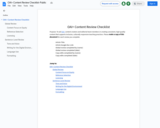
Purpose: To aid OAI+ content creators and editorial team members in creating consistent, high quality content that supports inclusive, culturally responsive teaching practices.

A one page review form with 8 overall criteria and tagging suggestions to provide a basic and quick overview of an OER.
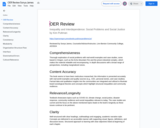
Review of OER textbook by Kim Puttman that covers the material's comprehensiveness, content accuracy, relevance/longevity, clarity, consistency, modularity, organization structure flow, interface, grammatical errors, and cultural relevance.
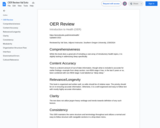
Review of OER textbook authored and adapted by Kelly Falcone that covers the material's comprehensiveness, content accuracy, relevance/longevity, clarity, consistency, modularity, organization structure flow, interface, grammatical errors, and cultural relevance.
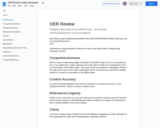
Review of OER textbook edited by Anh Nga Longva and Anne Sofie Roald that covers the material's comprehensiveness, content accuracy, relevance/longevity, clarity, consistency, modularity, organization structure flow, interface, grammatical errors, and cultural relevance.

This resource is a video abstract of a research paper created by Research Square on behalf of its authors. It provides a synopsis that's easy to understand, and can be used to introduce the topics it covers to students, researchers, and the general public. The video's transcript is also provided in full, with a portion provided below for preview:
"Microbial life can be found in nearly every environment on earth. These tiny organisms can significantly impact their surroundings, be it deep-sea microbes influencing the ecology of the ocean floor or the human gut microbiome affecting health. Metagenomics, or the analysis of microbial DNA in different environments, has dramatically increased what is known about microbial life. These sequencing-based techniques are not dependent on culturing microbes, which can be an incredibly difficult undertaking. However, isolating and cultivating microbes remains important to both confirm and expand upon those results. Moreover, cultivated microbes could potentially be used as probiotics or biocontrol agents or for industrial purposes. To date, most environmental microbes remain uncultured, but metagenomic data can be leveraged to help researchers isolate and cultivate new ones..."
The rest of the transcript, along with a link to the research itself, is available on the resource itself.
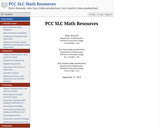
The material was written with review in mind, but there is enough detail that it would be useful for new students as well. Each topic includes written introductions, detailed examples, and practice exercises that are fully keyed. In addition, each chapter concludes with additional practice problems – those problems are not keyed, although short answers are provided. Many topics also include videos.

This resource is a video abstract of a research paper created by Research Square on behalf of its authors. It provides a synopsis that's easy to understand, and can be used to introduce the topics it covers to students, researchers, and the general public. The video's transcript is also provided in full, with a portion provided below for preview:
"Phospholipid scramblase 1 (PLSCR1) is the most studied member of its protein family and has a complex array of suggested functions. While PLSCR1 was first described as a plasma membrane protein, it has subsequently been found in other cellular compartments and implicated in numerous cellular pathways including apoptosis, intracellular trafficking of membrane proteins, and pro-inflammatory events. PLSCR1 interacts with various effectors, mediators, and regulators that then contribute to distinct cellular processes. While most PLSCR1 interactors are thought to be cell-type specific, the mechanisms of PLSCR1's regulatory functions are often shared. But not all PLSCR1 interactors are endogenous in origin; PLSCR1 also interacts with exogenous viral proteins. These interactions regulate viral uptake and spread in both pro- and anti-viral ways..."
The rest of the transcript, along with a link to the research itself, is available on the resource itself.
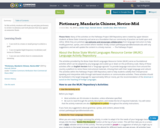
In this activity students will team up and play pictionary to review vocabulary and verb phrases that may appear on semester finals.